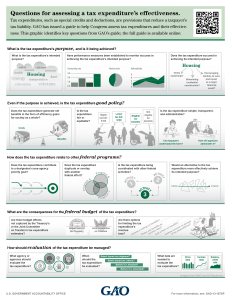Tax Expenditures: Spending through the Tax Code
How to Evaluate Tax Expenditures
(Excerpted from GAO-13-167SP)
To learn more about our work on tax expenditures—including links to recent reports—you can visit our Key Issue page.- Questions on the content of this post? Contact James R. White at whitej@gao.gov or James R. McTigue at mctiguej@gao.gov.
- Comments on GAO’s WatchBlog? Contact blog@gao.gov.

GAO's mission is to provide Congress with fact-based, nonpartisan information that can help improve federal government performance and ensure accountability for the benefit of the American people. GAO launched its WatchBlog in January, 2014, as part of its continuing effort to reach its audiences—Congress and the American people—where they are currently looking for information.
The blog format allows GAO to provide a little more context about its work than it can offer on its other social media platforms. Posts will tie GAO work to current events and the news; show how GAO’s work is affecting agencies or legislation; highlight reports, testimonies, and issue areas where GAO does work; and provide information about GAO itself, among other things.
Please send any feedback on GAO's WatchBlog to blog@gao.gov.

